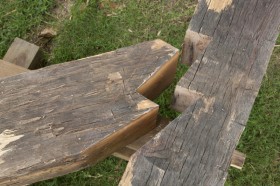Work to restore the Colonial Williamsburg Windmill is taking place at Great Hopes Plantation.
By Karen Gonzalez
An iconic Williamsburg image is coming back to life in the east pasture next to Great Hopes Plantation – one piece at a time.
[brightcove videoID=3640155608001 playerID=2893748186001 height=315 width=560]
The windmill that has been so popular with Colonial Williamsburg crowds since the 1950s is being restored and is expected to be back in operation by the summer of 2015.
“This windmill was built in 1957 for the Jamestown celebration,” says Matt Webster, director of the Grainger Department of Architectural Preservation for Colonial Williamsburg. “It was based on the Bourn Mill in Cambridgeshire, England, built in 1636.”
The 1957 version commemorated the 350th anniversary of the Jamestown settlement, but it suffered the kinds of problems that come with age. It stopped operating in the mid-1990s and was closed to visitors in 2003.
Seven years later, Colonial Williamsburg took the windmill apart and stored at the Palace Farms site with an eye toward eventual restoration and re-assemblage.
All windmills are not created equal. This particular one has a single center post, called a kingpost. The entire housing rotates on top of the kingpost. The millstones, massive gears and machinery that were used to grind corn and wheat are inside of the housing.
The Colonial Williamsburg Windmill as it looked in 1957.
The mill once stood behind the Peyton Randolph House and for years was known as Robertson’s Windmill. In that location, the wooden elements were damaged from exposure to termites and the weather. Tall trees in the area blocked the wind and stopped the rotation of the blades. When machinery stops moving, it quickly becomes nonfunctional and the wood begins to warp.
So what’s the goal?
“To repair it, make it stable as a structure and as a machine. ” Webster says.
In its new location, there will be good exposure to the wind and great visibility for visitors as they enter the historic area.
Journeyman carpenter Steve Chabra works with Webster to oversee the restoration and rebuilding of the wooden portions using tools and carpentry style of the day.
“There is a lot that we could do to make maintenance on this much easier, but then it would be a modern-day building. We don’t want that.” Webster says.
‘You have to think like an 18th century millwright’
Webster is the project manager and is responsible for keeping it historically accurate. “This is an extremely accurate mill for the 18th century and is one of the few out there.”
Meanwhile some of the wooden pieces are being fabricated and repaired offsite. They will be brought to Williamsburg this fall, with the major reconstruction beginning in January.
For now, the windmill parts are in pieces in the pasture next to Great Hopes Plantation.
The restoration is possible thanks to a commitment by longtime Colonial Williamsburg supporter David McShane of Bucks County, Pa.

To whom do we owe the funding for this project? It is nice to know because that way we may help support those generous owner’s businesses. Like we do M&M’s Forrest Mars for his generosity for the Coffeehouse and Armoury.
I have also missed the Windmill. My first trip to CW was as a junior in high school. Our chaperones also used the windmill as our gathering place.
Thanks,
Chris
This restoration is possible because of a commitment from a longtime Colonial Williamsburg supporter, David McShane of Bucks County, Pa.
Marsha Kazarosian says
Third windmill has been sorely missed! When we would go to Williamsburg with our parents in the ’60’s, the first rule was, “if we get separated, we all meet at the windmill!”
I am so happy to see this will be rebuilt. While not original, it has been missed and is a mill that could have been found either in the Jamestown, Yorktown or Wm’sburg area, though tide mills may have predated them followed by overshot or undershot water driven mills. This was so much fun on a windy day with the kids in the 70’s. I hated seeing sitting there rotting away. Glad it will be rebuilt at Great Hope.
Karen
Thank you for the article.
How was grain milled during the revolutionary times in the Williamsburg area? Was there a windmill near the town, or was a water powered mill used?
Dave
Dave,
Thanks so much for writing. Matt Webster offered this, which I hope answers your question:
I know of two post mills in Williamsburg: Robertson’s and one depicted on the Frenchman’s map south of the Public Hospital. There was a water mill at Jolly Pond and evidence of tidal mills. With these mills and product coming by road and water from other regions, Williamsburg was adequately supplied.